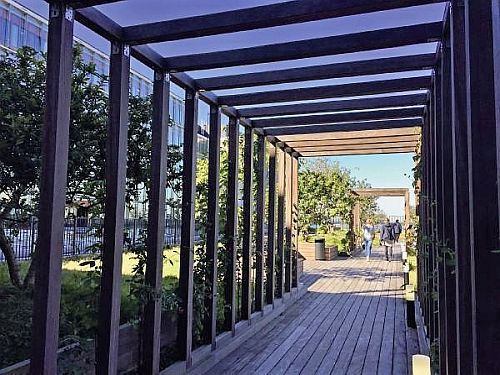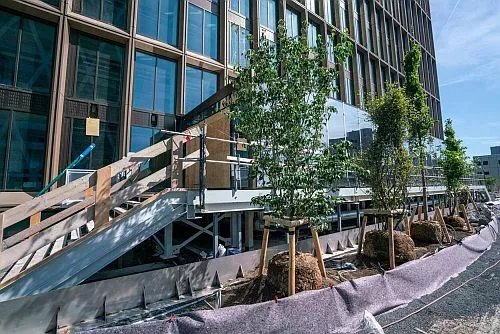Water retention roofs contributing to climate change solutions
Climate change challenges & construction solutions

With increased global warming we will increasingly have to deal with the threat of extreme drought and rain. These issues are a topic that is therefore very high on everyone's agenda.
With retention roofs, we can store and temporarily buffer rainwater that falls on flat roofs. But roofs with permanent water storage naturally place much higher demands on construction and materials. With the FOAMGLAS® Compact Roof system, every roof structure meets the highest standards in terms of sustainability and reliability.
In dry summers, river and groundwater levels often become very low indeed, to such an extent that in the following winter, rainstorms fail to replenish water resources. Climate change makes the difference between too much or too little water even more extreme. Dry periods become even drier, and when it rains, even more water falls from the sky in a short period of time. Indeed, as a result of global warming, our atmosphere contains more water vapor and clouds are therefore less likely to be saturated.
One step beyond green roofs
Classic green roofs are already an excellent solution. They retain rainwater that falls on the roof and then slowly release it via evaporation. They act as a kind of buffer and help avoid overloading the sewerage and water collection system during heavy rain.
Retention roofs, also called blue roofs, go one step further. Every green roof stores water, but you have little control over what exactly happens to it. With a retention roof, you do.
This has two advantages: during long periods of drought, retention roofs act as useful reservoirs, and during intense rainfall, rainwater will be delayed or not discharged to the sewer at all. Thus, in densely built-up, vulnerable areas, rainfall nuisance can be significantly reduced. And at the same time, retention roofs offer additional perspectives for sustainable reuse of the captured rainwater, e.g. for the toilet or watering plants. That is why retention systems are so often combined with a green roof.
Besides storing and buffering rainwater, retention roofs have another important additional benefit. Because rainwater has a cooling effect, indoor temperatures will stay lower. This provides more comfort during summer and significant savings on air conditioning.
As water is permanently on roofs, retention roofs have to meet particularly strict requirements. Not only the consequential damage to the underlying residential or commercial spaces, but also the damage to the roof's infrastructure and the furnishing of, for example, an ornamental pond can be enormous. Extra care must therefore be taken with the quality of materials, design and permanent protection of the waterproofing layer. No concessions should be made to the execution and connections either.
The substructure of a retention roof almost always consists of concrete. Concrete is waterproof, except in weaker areas such as penetrations or upstands. Therefore, a concrete substructure must be combined with waterproof insulation that is fully adhered to the substructure. If the roof covering should be damaged, the risk of the point of penetration coinciding with a weak spot in the substructure is very small. Should this exceptionally be the case, the problem can be remedied quickly, because the seal failure is local and can be detected quickly. And - above all - the FOAMGLAS® Compact Roof principle makes horizontal water transport absolutely impossible.
In a FOAMGLAS® Compact roof structure, water- and vapour-tight cellular glass insulation is fully adhered to the substructure (concrete) or substrate (a fully adhered back-up layer) using bitumen, with all seams also filled with bitumen. This complete and mutual adhesion ensures that moisture cannot migrate above, below, between or within the insulation boards. Therefore, provided proper execution and detailing, damage will never lead to leakage damage or consequential damage.
FOAMGLAS® roof insulation with a permanent U-value
It is not only the exceptional waterproofing that makes a FOAMGLAS® Compact Roof the ideal solution for retention roofs. In the use phase, it is important that the roofing construction retains its original performance. For more than 50 years, cellular glass insulation has proven to be the most securely insulated roofing construction material. The closed structure of the glass cells in which it is constructed makes cellular glass an exceptionally reliable insulation material for the most demanding types of actively used roofs: water roofs, patio roofs, green roofs, parking roofs.
Cellular glass is the only insulation material that has been proven to retain its insulation value even when the roof membrane is damaged or worn. Even after almost half a century, FOAMGLAS® Compact Roofs are still as dry and effective as when they were realized. A FOAMGLAS® Compact Roof is 100% waterproof and vapor tight, so it also remains 100% dry.
The best compressive strength
In addition, cellular glass also has the best compressive strength of all insulation materials. The compressive strength of FOAMGLAS® slabs for roofing applications ranges from 0.5 to 1.6 MPa, depending on the desired level of insulation. This means that the boards can support loads of 50 to 160 tones per m². FOAMGLAS® insulation also retains its shape and dimensional stability, at all temperature cycles, under all conditions and under any load, throughout the life of a building.
Given its exceptional water tightness, high and long-term reliability and exceptional compressive strength, the FOAMGLAS® Compact Roof system is increasingly used for retention roofs. Such as in the European Medicines Agency (EMA) building on the Zuidas in Amsterdam.
To avoid overloading the public sewer system during heavy rainfall, the supply during this peak load should be reduced as much as possible. This can be done, for example, by constructing water storage tanks underground, by creating ‘wadi’s, ponds or overflow areas and, in urban areas, increasingly by building water buffers on roofs. Several countries have now established regulations for this purpose. These regulations may, for instance, set requirements for the required delay with which rainwater from a plot may be distributed to the sewer. There are also government aids for different solutions. The regulations are very diverse and can be different for each local authority.








